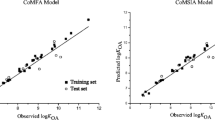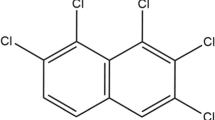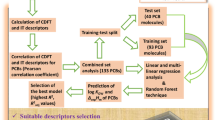Abstract
Based on the experimental subcooled liquid vapor pressures (P L) of 17 polychlorinated naphthalene (PCN) congeners, one type of three-dimensional quantitative structure–activity relationship (3D-QSAR) models, comparative molecular similarity indices analysis (CoMSIA), was constructed with Sybyl software. Full factor experimental design was used to obtain the final regulation scheme for PCN, and then carry out modification of PCN-2 to significantly lower its P L. The contour maps of CoMSIA model showed that the migration ability of PCN decreases when the Cl atoms at the 2-, 3-, 4-, 5-, 6-, 7- and 8-positions of PCNs are replaced by electropositive groups. After modification of PCN-2, 12 types of new modified PCN-2 compounds were obtained with lnP L values two orders of magnitude lower than that of PCN-2. In addition, there are significant differences between the calculated total energies and energy gaps of the new modified compounds and those of PCN-2.

Similar content being viewed by others
References
Chen JW, Yang P, Chen S (2003) Quantitative structure-property relationships forvapor pressures of polybrominated diphenyl ethers. Sar Qsar Environ Res 14:91–111. doi:10.1007/s001280001
Chen Y, Cai XY, Jiang L (2016) Prediction of octanol-air partition coefficients for polychlorinated biphenyls (PCBs) using 3D-QSAR models. Ecotoxicol Environ Saf 124: 202–212. doi:10.1016/j.ecoenv.2015.10.024
Clark M, Cramer RD, Vanopdenbosch N (1989) Validation of the general purpose tripos 5.2 force field. J Comput Chem 10:982–1012. doi:10.1002/jcc.540100804
Corsolini S, Kannan K, Imagawa T (2002) Polychloronaphthalenes and other dioxin-like compounds in Arctic and Antarctic marine food webs. Environ Sci Technol 36:3490–3496. doi:10.1021/es025511v
Falandysz J, Strandberg B, Strandberg L, Bergqvist P, Rappe C (1997) Concentrations and biomagnification of polychlorinated naphthalenes in black cormorants phalacrocorax carbo sinensis from theGulf of Gdansk, Baltic Sea. Sci Total Environ 204:97–106
Gasteiger J, Marsili M (1980) Iterative partial equalization of orbital electronegativity a rapid access to atomic charges. Tetrahedron 36:3219–3228. doi:10.1016/0040-4020(80)80168-2
Golbraikh A, Tropsha A (2002) Beware of q2! J Mol Graph Model 20:269–276.
Helm P, Bidleman T, Li H (2004) Seasonal and Spatial Variation of Polychlorinated Naphthalenes and Non-/Mono-Ortho-Substituted Polychlorinated Biphenyls in Arctic Air. Environ Sci Technol 38:5514–5521
Jiang L, Li Y (2016) Modification of PBDEs (BDE-15, BDE-47, BDE-85 and BDE-126) biological toxicity, bio-concentration, persistence and atmosphericlong-range transport potential based on the pharmacophore modeling assistant with the full factor experimental design. J Hazard Mater 307:202–212. doi:10.1016/j.jhazmat.2015.12.031
Khabeev NS, Shagapov VS, Yumagulova YA, Bailey SS (2015) Evolution of vaporpressure at contact with liquid. Acta Astronaut 114:147–151. doi:10.1016/j.actaastro.2015.05.003
Kilanowicz A, Skrzypinska-Gawrysiak, M 2010 Toxicity of hexachloronaphthalene (HxCN) and induction of CYP 1 A in rats. Ecotox Environ Saf 73:196–205. doi:10.1016/j.ecoenv.2009.08.018
Leach AR (2001) Molecular modelling: principles and applications. Person Education Limited Harlow, England
Lei YD, Wania F, Shiu WY (1999) Vapor pressures of thepolychlorinated naphthalenes. J Chem Eng Data 44:577–582. doi:10.1021/je9802827
Li XL, Ye L, Shi W (2013) In silico study on hydroxylated polychlorinated biphenyls as androgen receptor antagonists. Ecotoxicol Environ Saf 92:258–264. doi:10.1016/j.ecoenv.2013.03.008
Liu HX, Zhang QH, Jiang GB (2005) Polybrominated diphenyl ethersand its related environmental problems. Prog Chem 17:554–562. doi:10.3321/j.issn:1005-281X.2005.03.022
Lv YY, Yin CS, Liu HY (2008) 3D-QSAR study on atmospheric half-lives of POPs using CoMFA and CoMSIA. J Environ Sci-China 20:1433–1438. doi:10.1016/S1001-0742(08)62545-0
Puzyn T, Falandysz J (2005) Computational estimation of logarithm of n-octanol/air partition coefficient and subcooled vapor pressures of 75 chloronaphthalene congeners. Atmos Environ 39:1439–1446. doi:10.1016/j.atmosenv.2004.11.022
Wong A, Lei YD, Alaee M, Wania F (2001) Vapor pressures of the polybrominated diphenyl ethers. J ChemEng Data 46:239–242. doi:10.1021/je0002181
Yamashita N, Kannan K, Imagawa T, Miyazaki A, Giesy JP (2000) Vertical profile of dioxin-like and estrogenic activities associated with a sediment core from Tokyo Bay, Japan. Environ Sci Technol 34:4236–4271. doi:10.1021/es001044a
Zhang LL, Zhang LF, Dong L, Huang Y, Li XX (2015) Concentrations and patterns of polychlorinated naphthalenes in surface sediment samples from Wuxi, Suzhou, and Nantong, in East China. Chemosphere. 138:668–674. doi:10.1016/j.chemosphere.2015.07.045
Author information
Authors and Affiliations
Corresponding author
Rights and permissions
About this article
Cite this article
Gu, W., Chen, Y. & Li, Y. Attenuation of the Atmospheric Migration Ability of Polychlorinated Naphthalenes (PCN-2) Based on Three-dimensional QSAR Models with Full Factor Experimental Design. Bull Environ Contam Toxicol 99, 276–280 (2017). https://doi.org/10.1007/s00128-017-2123-5
Received:
Accepted:
Published:
Issue Date:
DOI: https://doi.org/10.1007/s00128-017-2123-5




